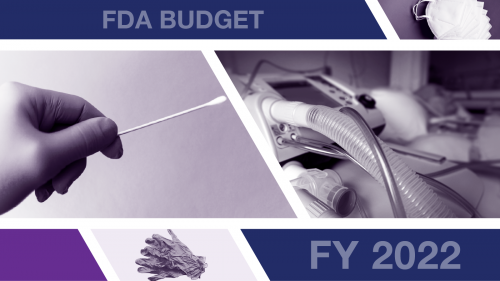Image

By: Janet Woodcock, M.D., Acting Commissioner of Food and Drugs
The U.S. Food and Drug Administration’s Devices Program is responsible for the regulation and oversight of a wide range of medical devices that patients and their health care providers use every day. These devices range from simple tongue depressors to complex instruments that help save and sustain life, such as heart valves, the artificial pancreas, and programmable pacemakers with micro-chip technology.
Throughout the COVID-19 public health emergency, the FDA has taken many actions to help ensure that patients and health care providers have timely and continued access to high-quality medical devices. One such action was implementation of the Coronavirus Aid, Relief, and Economic Security Act (CARES Act), which was signed into law on March 27, 2020, and gave the FDA, for the first time, statutory authority intended to help prevent or mitigate device shortages during, or in advance of, a public health emergency. However, the pandemic has exposed great weaknesses in the medical device supply chain and its dependence on foreign medical devices. To ensure the U.S. is properly prepared now, and in the future, we must take action to secure our medical device supply chain, including related materials, parts, and components. The FDA recognizes that this will take resources and expanded authority.
The investments outlined in the FDA’s FY 2022 budget include $21.6 million for a new Resilient Supply Chain and Shortages Prevention Program (RSCSPP) in the Center for Devices and Radiological Health (CDRH). This funding will provide, for the first time, resources to establish a permanent program for U.S. supply chain resilience for medical devices. The funding will help to stand up this program, which will build on the work done to implement the CARES Act during the COVID-19 public health emergency, and will focus on strengthening the domestic supply chain through investments in preventive measures, identifying potential medical product supply short-falls, continuing surveillance, and rapid intervention.
Additional Authorities to Build a More Resilient Supply Chain
With passage of the CARES Act, Congress enacted new statutory authority to help the FDA address shortages of critical devices in the midst of a global pandemic. These new authorities have enabled the agency to collect information submitted by manufacturers about supply chain disruptions to help prevent and mitigate the impact of critical shortages caused or exacerbated by the COVID-19 pandemic. However, the statutory authorities relating to device shortages are more limited than those available to respond to drug shortages. In particular, the temporal limitation and tie to public health emergencies (PHE) for manufacturers to submit device shortage notifications puts the FDA behind in responding to early signs of supply constraints or a potential shortage.
COVID-19 has shown us that it is too late to build an infrastructure and establish an understanding of the supply chain while a PHE or other type of emergency is happening. We saw firsthand that by the time there is an emergency it is often too late to prevent or mitigate shortages. Supply chain disruptions were already beginning to occur before COVID-19 cases were identified in the U.S., as other nations had outbreaks and needed personal protective equipment (PPE), testing supplies, and other equipment in excess of supply. Moreover, there are situations such as hurricanes and other natural disasters that may not ever rise to the level of a PHE, but for which disruptions in device availability could significantly impact patient care.
To assure a more resilient domestic supply chain, prevent shortages before they occur, and reduce dependence on foreign production, the FDA needs expanded authority to obtain supply disruption notifications for critical devices any time there is the potential for a shortage (removing the temporal limitation to PHEs). In addition, the FDA has requested that these notifications include production volume information to help facilitate conducting fuller oversight of supply chain disruptions. The FDA has also requested authority to require manufacturers to develop and share risk management plans and identify alternate suppliers and manufacturing sites, as well as authority for the FDA to allow temporary importation of unapproved devices, with appropriate controls, when in the interest of the public health.
The New Resilient Supply Chain and Shortages Prevention Program
The importance of a robust supply chain has never been more evident than during the COVID-19 pandemic, when the nation’s response relies upon the availability of devices such as PPE, ventilators, in vitro diagnostic tests, and the components necessary to run them and other critical devices.
The establishment of a permanent device shortages program will help ensure U.S. patients and health care providers have access to the critical medical devices they need and help reduce U.S. dependence on devices from other nations.
The RSCSPP will enhance CDRH’s capacity to enable rapid intervention to prevent and mitigate supply chain interruptions through:
- Proactive regulatory measures and partnerships with industry, health care providers, patients, and others.
- Development and application of state-of-the-art supply chain intelligence for predictive modeling.
- Early signal detection and continuous surveillance.
- Fostering a more resilient domestic supply chain through investments in preventive measures that help to avert shortages before they occur.
This dedicated funding will strengthen CDRH’s capability to respond in everyday situations, as well as in emergencies. Funding for a permanent device shortages program at the FDA is critical to decrease or eliminate the risk of medical device supply chain shortages, and part of the agency’s overall investment in core FDA safety programs.
We look forward to continuing to work with Congress to ensure the FDA has the resources and authority it needs to carry out our vital public health mission to protect and promote the public health.
"device" - Google News
July 21, 2021 at 07:00AM
https://ift.tt/2V0mw27
FDA's Budget: Medical Device Supply Chain and Shortages Program - FDA.gov
"device" - Google News
https://ift.tt/2KSbrrl
https://ift.tt/2YsSbsy
Bagikan Berita Ini















0 Response to "FDA's Budget: Medical Device Supply Chain and Shortages Program - FDA.gov"
Post a Comment